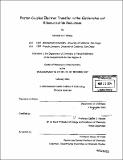| dc.contributor.advisor | Daniel G. Nocera. | en_US |
| dc.contributor.author | Chang, Michelle C. Y. (Michelle Chia-yu), 1977- | en_US |
| dc.contributor.other | Massachusetts Institute of Technology. Dept. of Chemistry. | en_US |
| dc.date.accessioned | 2006-03-24T18:16:32Z | |
| dc.date.available | 2006-03-24T18:16:32Z | |
| dc.date.copyright | 2004 | en_US |
| dc.date.issued | 2004 | en_US |
| dc.identifier.uri | http://hdl.handle.net/1721.1/30067 | |
| dc.description | Thesis (Ph. D.)--Massachusetts Institute of Technology, Dept. of Chemistry, 2004. | en_US |
| dc.description | Vita. | en_US |
| dc.description | Includes bibliographical references. | en_US |
| dc.description.abstract | Ribonucleotide reductases (RNRs) comprise a biologically indispensable enzyme class which converts the four common nucleotides to their corresponding deoxynucleotides via a thiyl radical hydrogen abstraction mechanism. As this is the only cellular pathway for production of the monomeric precursors required for DNA synthesis, the regulation of RNR is crucial to controlling the cell cycle by the availability of substrate pools for DNA replication. The class I RNR from E. coli is composed of two subunits; the R1 subunit contains the active site for nucleotide reduction, as well as the allosteric effector binding sites, and the R2 subunit contains the stable Y122·-diiron cofactor. Based on the conserved mode of action of the class II and mII RNRs, Y122· is proposed to oxidize C439 in R1 to the active thiyl radical species through a long-range radical transfer pathway involving several conserved aromatic residues (in R2: Y122, W48, Y356; in RI:Y731, Y730), which is unprecedented for its length (35 [angstroms]). Although this model is supported by in vitro and in vivo mutagenesis studies as well as sequence conservation, direct evidence for radical intermediates along this pathway has been masked by conformational gating. We have initiated R1 nucleotide reduction in the absence of R2, using a photoactive derivative of the R2 C-terminal peptide, containing the essential Y356. This peptide is capable of generating a tyrosyl radical upon photolysis and provides a specific entry point into the radical initiation pathway of R1. We now report that catalytic turnover in R1 may be triggered in the absence of R2 by the photogeneration of a conserved aromatic amino acid radical located within a synthetic 21-mer peptide derived from the R2 C-terminus. | en_US |
| dc.description.abstract | (cont.) Mutation of conserved tyrosines on the pathway, corresponding to Y356 and Y731, to phenylalanine effectively deactivates radical initiation. These results provide the first direct evidence of the radical transfer pathway of the class I RNRs and underscore the importance of aromatic amino acid radical intermediates for proton-coupled electron transfer in physiologically-relevant processes. | en_US |
| dc.description.statementofresponsibility | by Michelle C.Y. Chang. | en_US |
| dc.format.extent | 289 leaves | en_US |
| dc.format.extent | 11432794 bytes | |
| dc.format.extent | 11432594 bytes | |
| dc.format.mimetype | application/pdf | |
| dc.format.mimetype | application/pdf | |
| dc.language.iso | eng | en_US |
| dc.publisher | Massachusetts Institute of Technology | en_US |
| dc.rights | M.I.T. theses are protected by copyright. They may be viewed from this source for any purpose, but reproduction or distribution in any format is prohibited without written permission. See provided URL for inquiries about permission. | en_US |
| dc.rights.uri | http://dspace.mit.edu/handle/1721.1/7582 | |
| dc.subject | Chemistry. | en_US |
| dc.title | Proton-coupled electron transfer in the Escherichia coli ribonucleotide reductase | en_US |
| dc.type | Thesis | en_US |
| dc.description.degree | Ph.D. | en_US |
| dc.contributor.department | Massachusetts Institute of Technology. Department of Chemistry | |
| dc.identifier.oclc | 55629288 | en_US |
